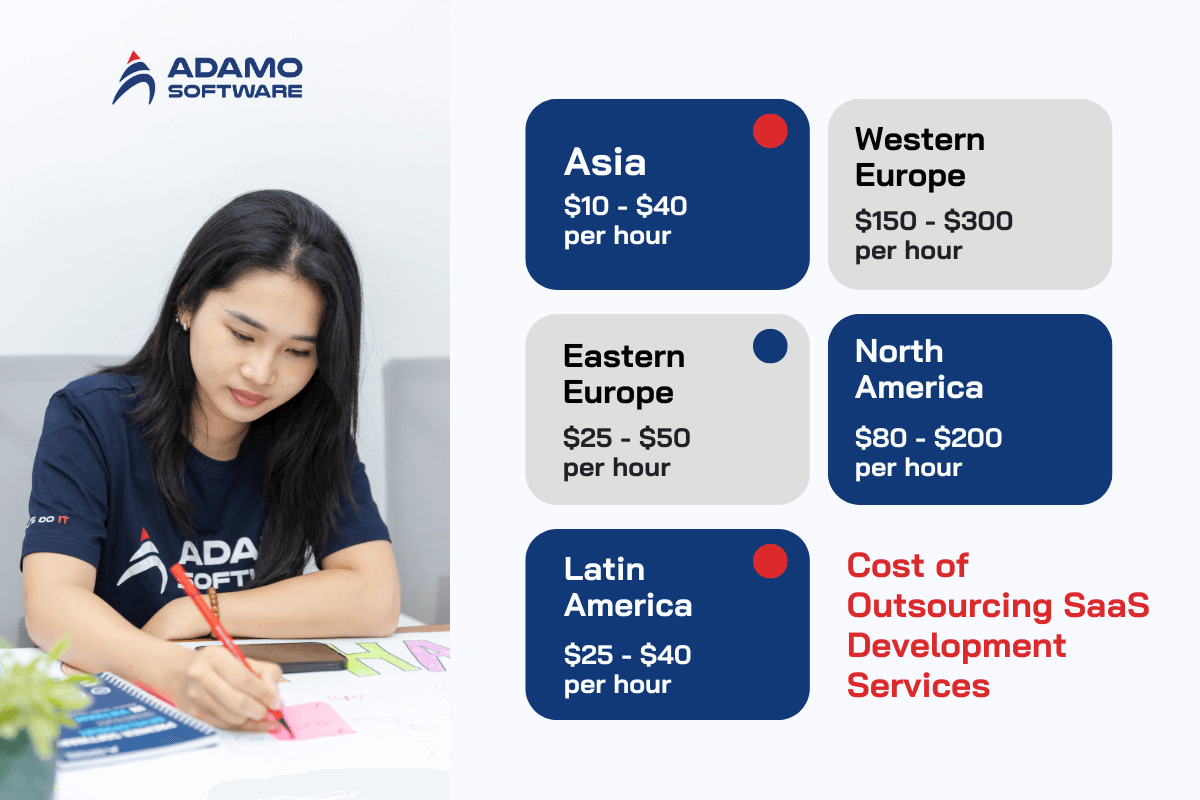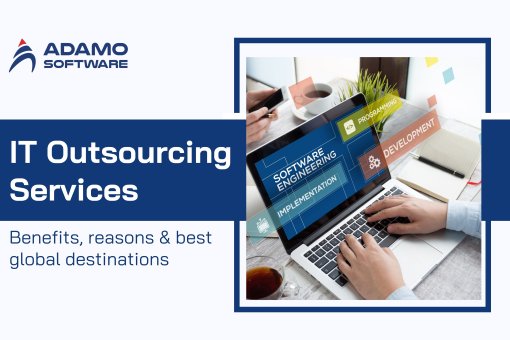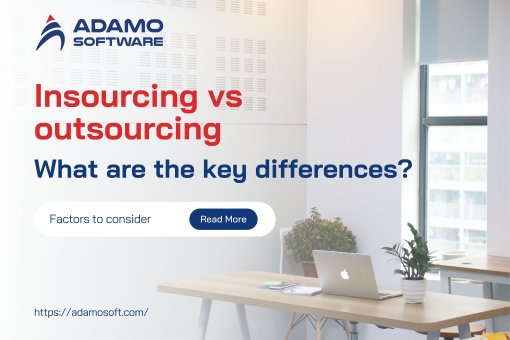The Ultimate Guide to Outsourcing SaaS Development 2026

Outsourcing SaaS development to a team overseas has become a popular approach for businesses aiming to reduce operational costs.
According to ExplodingTopics.com, SaaS applications account for 70% of total company software use, making it a growing market with high demand for SaaS outsourcing services.
In this article, we’ll explore the benefits of outsourcing SaaS projects as well as different outsourcing models that can best fit your business. We’ll also provide guidance on how to prepare for outsourcing and find the right partner.
I. Why Business Should Outsource SaaS Development
Software as a Service (or SaaS) is a way to use applications over the Internet as a service. Instead of installing and taking care of software on your computer, you just use it online. This makes things easier because you don’t have to worry about managing complex software and hardware.
SaaS applications are also called web-based software, on-demand software, or hosted software. They run on the provider’s servers, and the provider takes care of everything, including security, availability, and performance.
You can access SaaS applications through a web browser, desktop app, or mobile app. For example, Google Docs is a popular SaaS tool. It allows you to write and edit documents online just by logging into your Gmail account, and you can use it from anywhere.
However, creating and maintaining a SaaS product requires a lot of money, technical skills, and other resources. It’s also time-consuming. Because of these challenges, many businesses now choose to outsource their SaaS development.
_ Building a SaaS product involves many components and can take a lot of time and energy. About 40% of CTOs believe that outsourcing helps manage work better in a fast-paced environment.
_SaaS projects need various tools, services, and APIs that require constant support and monitoring. Outsourcing can save you money and reduce the need for additional human resources.
_ To keep up with market demands, SaaS products need to evolve quickly. Users expect new features regularly, so product owners need to adopt new technologies and scale up their projects. Outsourcing SaaS development can help you meet these expectations more effectively.
II. Benefits of SaaS Outsourcing Development

1. Time and Cost Saving
When companies manage everything internally, they have to pass these costs to their customers. Working with an outsourcing SaaS development company, businesses can cut some of these costs, giving them a price advantage over competitors.
Instead of hiring more staff for your IT department, it’s better to delegate these tasks to a competent software outsourcing company. These businesses employ certified specialists and have lower overhead costs for offices, equipment, software, and cloud infrastructure. You only pay for the work done and the results.
Outsourcing SaaS development companies also offer a full cycle of IT project development and maintenance, helping you save money on software development.
2. Access to Global Top Tech Talent
Small businesses often lack the resources to set up all the systems and services they need. Plus, software licenses and equipment upkeep are usually very expensive.
Outsourcing SaaS development helps smaller businesses compete with larger ones by giving them access to top tech talent. For short-term needs, finding and hiring highly-skilled individuals can be costly and time-consuming.
SaaS outsourcing allows you can quickly get skilled professionals to handle your IT tasks, ensuring high-quality performance.
3. Flexible Staffing Options and Team Structure
The product development cycle can be unpredictable, sometimes taking longer or using more resources than expected. Market trends, customer expectations, and project scope can all impact the work process.
With an outsourcing SaaS development team, you can adjust your team size as needed. You can scale up or down at different stages of the project, hiring developers on a temporary basis.
This flexibility lets you avoid spending on idle staff and prevents your in-house team from getting overloaded and burned out.
4. Focus on Business’s Core Competencies
One big advantage of outsourcing is that you can focus on your core business activities while letting experts handle the software development tasks.
You don’t need to worry about hiring specialists or investing in staff training. Thanks to this, you can concentrate on growing your business and other important priorities, while the outsourcing team handles the technical challenges.
Your in-house resources can then focus more effectively on tasks that are crucial for your product’s success and your company’s performance.
5. Stay Up-to-date with Emerging Innovations and Technologies
In today’s software development projects, using the latest technology is crucial. The tech stack evolves rapidly, and in-house teams often can’t keep up with all the changes.
Outsourcing companies, however, have senior developers who are experts in many fields and stay up-to-date with the latest technology stacks. So that your projects use the most recent advancements in technology.
Also read: SaaS Tech Stack to Build Your SaaS from Scratch 2026
III. Challenges of SaaS Development Services
While outsourcing SaaS development has many benefits, watch out for these challenges
1. Choosing a reliable partner for outsourcing SaaS development
Finding a reliable SaaS team can be very challenging. You want a partner that you can trust and that will be fully committed to your project’s success. It’s also important that they understand your target audience and business goals and can align their software goals with those.
2. Fraudulent contracts
Make sure you clearly understand the terms of the contract with the outsourcing firm. If not, you might face unexpected issues, like extra costs for services or additional fees for small changes after signing. It’s a good idea to have your outsourcing partner sign a non-disclosure agreement and a contract with no loopholes.
3. Lack of accepted coding methods
Sometimes the quality of the code used by the outsourcing team may not meet your standards. It’s crucial to work with organizations whose coding methods you understand and who have coding standards that are even better than your internal teams.
4. Project milestone delays
Delays in meeting project milestones can happen due to communication issues or technical problems, especially since most interactions with the outsourced team are digital. Even top development firms might miss a milestone or two. Here are three common causes of project delays:
_ Unrealistic expectations: Setting goals that are too ambitious from the start.
_ Scope creep: Uncontrolled changes or additions to the project’s functionalities.
_ Poor risk management: Not having a proper process to handle risks.
To avoid these issues, choose software partners experienced in setting realistic objectives, providing accurate estimates, and creating clear guidelines for project revisions and improvements.
Quick Tip: For smoother processes in SaaS development outsourcing, hold frequent video conferences or face-to-face meetings.
IV. 3 Models of Outsourcing SaaS Development
Outsourcing SaaS development isn’t a one-size-fits-all solution. You have many options to consider, depending on what fits best with your business needs. We’ve outlined the top three models, along with their pros and cons, to help you make the best choice.

1. Dedicated Team
This model is perfect for SaaS startups that need to stick to a budget and meet deadlines. If you don’t have the resources to hire an in-house team, but still need dedicated workers, this option is ideal.
With a dedicated team, your SaaS product will be managed by experienced developers. You’ll have regular communication, flexibility, and great time management. This model is great for adapting to any changes in your project’s scope or requirements.
Pros:
_ Predictable and reduced project timeline and budget.
_ Frequent and good communication with the team.
_ Strong commitment from the development team.
_ High flexibility in managing the project.
_ Developers have extensive knowledge about SaaS.
_ No long-term training needed.
Cons:
_ Not a one-size-fits-all solution for every SaaS product.
_ Best suited for long-term projects.
_ Time zone differences may need to be considered.
2. Project-based
This approach works well for SaaS projects that don’t need to grow or change much. If your product has a set budget and timeline, you can agree on a fixed-price contract. This is good for small to medium-sized projects with a clear development plan.
Pros:
_ Transparency and reliability from your development experts.
_ No need to constantly monitor or manage the team.
_ Fewer budget and timing challenges.
Cons:
_ Requirements must be clear and well-defined. Unclear scope can lead to overpricing.
_ More communication challenges.
_ Risk of not achieving the highest quality for the product.
_ Development teams may be less adaptable.
3. Staff Augmentation
This model is great for companies that develop their products in-house but need extra help for specific tasks. You outsource part of the project to specialized developers while keeping overall control. This saves time and money by using expert help without a long-term commitment.
Pros:
_ Better control over most of the development process.
_ Flexibility in hiring new experts.
_ Saves resources by adding top tech experts to your team.
Cons:
_ Requires extra effort for training new employees.
_ Challenges in coordinating different teams working on the same project.
_ Outsourced staff may rely heavily on your internal procedures.
V. How to Start Your Outsourcing SaaS Development Project
To ensure your project runs smoothly, here are 3 steps to outsourcing SaaS development:
1. Evaluate skills of your current team to define what you need
Before outsourcing SaaS development, figure out what skills you need. Assess your team’s abilities and identify any gaps. Once you know what skills are missing, create a project specification that outlines what the product should do and how the work should be carried out. Then, contact the outsourcing companies on your shortlist and choose the one that fits best.
2. Verify the quality of SaaS outsourcing vendors
Before hiring a software development company, check their reputation. Look at their website and read their case studies. Also, check third-party review sites and their social media to see how they are viewed in the industry. Finally, contact their previous clients to verify the quality of their work.
3. Implement project management tools
After choosing your outsourcing team, use project management tools to track progress. Platforms like Basecamp or Trello help assign tasks to specific developers and enable communication through calendars and messaging threads. Your outsourcing SaaS development company should appoint an engineering manager and team leaders to ensure milestones are met and responsibilities are handled.
The key to successful software development outsourcing is communication. When communication channels are open, projects can move forward efficiently and launch on time. Finding an outsourcing SaaS development company, you want to work with long-term might take time, but the positive impact on your business makes the effort worthwhile.
VI. Cost of Outsourcing SaaS Development Services
The cost of outsourcing SaaS development varies by region. Based on our research, here are the costs in different regions to help you decide the best place to outsource for your clients:

1. Asia
Countries like Vietnam, India, Pakistan, and Kazakhstan fall under this region. Professionals here offer competitive rates, which are the cheapest. Rates range from $10 to $40 per hour, depending on the country and project complexity.
2. Western Europe
Western European countries, including the United Kingdom, France, and Germany, have higher SaaS development rates due to more developed IT industries. Rates here range from $150 to $300 per hour.
3. Eastern Europe
This region is popular for hiring SaaS development professionals due to its highly skilled workforce. Countries like Ukraine, Poland, and Romania fall under this region. The average rates are $25 to $50 per hour.
4. North America
This region includes the United States and Canada, where rates are higher. The average cost for software development ranges from $80 to $200 per hour, based on the required expertise and project complexity.
5. Latin America
Countries like Brazil, Argentina, and Colombia fall under this region. They offer competitive rates ranging from $25 to $40 per hour, depending on the country and project complexity.
Wrap up: The price differences between regions show a significant gap. The costs mentioned can vary based on various factors, so each company can find the best fit based on your budget and requirements.
VII. Top Locations for Outsourcing SaaS Development: Asia
With revenue expected to grow at an annual rate (CAGR 2024-2029) of 9.34%, leading to a market volume of $179.40 billion by 2029 (Statista), Asia is a key player in software outsourcing development.
Asian countries have earned a strong reputation in the SaaS outsourcing industry due to several key advantages:
Large and educated workforce
Asian countries often have a large pool of workers with diverse skills and educational backgrounds. Various countries in Asia have heavily invested in education and skill development, resulting in a well-educated workforce. Thanks to this, companies can find the specialized skills they need more easily. Besides, Asian countries have embraced emerging technologies like AI, automation, and cloud computing, which are needed for many outsourcing services.
English proficiency
English proficiency is a big advantage for Asian countries. Many countries prioritize English language education, so that their workforce have a high level of proficiency. According to EF, the Philippines, China, and Vietnam rank highest in the region for English proficiency.
Cost savings
Outsourcing SaaS development in Asia offers cost advantages in terms of labor costs compared to Western countries. Because of the lower cost of living and wages in Asian nations, you can access skilled labor at more affordable rates. So, if you are looking to reduce operational expenses while maintaining high-quality work, opt for Asia. The average hourly rate in Asia only ranges from $10 to $45, while rates in North America and Western Europe can reach up to $250 per hour.
Government support
Asian governments recognize the potential of the outsourcing industry and actively support its growth. They have invested in infrastructure development, including robust telecommunications networks, reliable power supply, and modern office spaces.
Now, let’s find out Top 5 Asian countries to hire SaaS developers
1. Vietnam
Vietnam is emerging as a top destination for outsourcing SaaS development. This country has a young and dynamic workforce with a strong focus on technology and innovation. Vietnamese developer skills are really impressive, ranking 2nd in Southeast Asia and 22nd worldwide. Besides, Vietnam offers cost-effective solutions with rates of $10-$40 per hour, saving up to 50%-70% compared to the US, Europe, India, and China.
2. India
India is well-known as a global SaaS outsourcing destination. It has a large pool of skilled IT professionals, competitive pricing, and a favorable business environment. India’s software outsourcing industry caters to diverse needs across various domains. According to Statista, India’s revenue in the IT outsourcing market is expected to grow at a CAGR of 17.92% from 2023-2028, reaching $20.09 billion by 2028. English is one of the official languages of India, so that you can ensure high proficiency among IT specialists here if you want to choose India to be your outsourcing SaaS development destination.
3. China
China has also become a major center for IT and other service industries, thanks to government focus, investment, and a large population of talented engineers. China offers competitive advantages in software development and other IT services. According to KPMG, 18% of U.S.-based organizations outsource their R&D work to China. This country has a strong focus on emerging technologies like AI and blockchain, extending its outsourcing capabilities beyond software development to include hardware manufacturing and IT infrastructure services.
4. The Philippines
The Philippines is famous for being professional at English. They’re ranked 2nd in Asia and 20th worldwide for English skills. In the Philippines, they work round the clock with call centers and offices open all day and night, so they can help clients from different time zones. Most of their outsourcing customers come from North America, especially the U.S. and Canada.
5. Malaysia
Malaysia is working hard to be a top spot for software outsourcing. While they’re not as good in English as the Philippines in Southeast Asia, they have better laws to protect your work. This means your stuff stays secret and safe, with less risk of being stolen or hacked. Malaysia has smart people ready to work and they offer good prices for software development services.
VIII. Contractual Models of SaaS Development Outsourcing to Consider
When you’re outsourcing SaaS development, you have three types of contracts to choose from, depending on your project’s goals and complexity:
1. Time and materials (T&M)
This type focuses on the results and sets a price for every hour of work.
_ Good for projects with changing requirements and need quick adjustments.
_ Ideal if you need ongoing help after the project’s done, like maintenance or fixing bugs.
2. Fixed price
This approach is setting a fixed price that won’t change, no matter how long the project takes.
_ Easier to plan and budget without worrying about extra costs.
_ Best for projects with clear requirements and limited changes.
3. Target cost
These contracts are a bit risky because they don’t have a set price.
_ Suitable for big projects with unclear scope.
_ Suppliers might give an upfront cost to make things clearer.
Tips for Handling Contracts with Outsourcing Vendor
When you’re making a deal with an outsourcing company, it’s a big deal. Here are some tips to handle it properly:
_ Make sure the contract spells out the time and cost for the vendor’s work.
_ Define what needs to be done, how it’ll be checked, and how often you’ll communicate.
_ Decide who approves things and who to contact if there are problems.
_ Make sure the contract clearly says who owns what.
_ Sign a Non-Disclosure Agreement (NDA) to keep important info safe.
_ Follow your country’s rules to avoid any trouble.
IX. Adamo Software – Trustworthy Partner for Outsourcing SaaS Development
Adamo Software – a premier outsourcing SaaS development company in Vietnam, we dive deep into every project specification, ensuring meticulous attention to detail. Our workflow is distinguished by our unique design-thinking mindset, ensuring that each project is completed punctually. With a 5-step approach to software development—empathize, define, ideate, prototype, and test—we maintain a swift pace while upholding top-notch quality.
Our services cater to companies of all sizes, from startups to global corporations. Guided by an Agile mentality, empowered by technology, and fueled by talent, we are committed to delivering excellence in every project we undertake.
At Adamo Software, we have had the privilege of collaborating with esteemed clients in several industries such as Travel and Hospitality, Digital Health, EdTech, Entertainment, Fintech.
So, if you have a software development idea in mind, contact us so we can assist you in bringing it to the market.











